Greenhouse Gases and
Society
by Nick Hopwood and Jordan
Cohen
Greenhouse gases naturally
blanket the Earth and keep it about 33 degrees Celsius warmer than it would be
without these gases in the atmosphere. This is called the Greenhouse
Effect. Over the past century, the Earth has increased in temperature by
about .5 degrees Celsius and many scientists believe this is because of an
increase in concentration of the main greenhouse gases: carbon
dioxide, methane, nitrous oxide, and fluorocarbons. People are now calling
this climate change over the past century the beginning of Global
Warming. Fears are that if people keep producing such gases at increasing
rates, the results will be negative in nature, such as more severe floods and
droughts, increasing prevalence of insects, sea levels rising, and Earth's
precipitation may be redistributed. These changes to the environment will
most likely cause negative effects on society, such as lower health and
decreasing economic development. However, some scientists argue that
the global warming we are experiencing now is a natural phenomenon, and is part
of Earth's natural cycle. Presently, nobody can prove if either theory is
correct, but one thing is certain; the world has been emitting greenhouse gases
at extremely high rates and has shown only small signs of reducing emissions
until the last few years. After the 1997 Kyoto Protocol, the world has
finally taken the first step in reducing emissions.
The Greenhouse
Effect The "greenhouse effect"
is the heating of the Earth due to the presence of greenhouse gases. It is
named this way because of a similar effect produced by the glass panes of a
greenhouse. Shorter-wavelength solar radiation from the sun passes through
Earth's atmosphere, then is absorbed by the surface of the Earth, causing it to
warm. Part of the absorbed energy is then reradiated back to the
atmosphere as long wave infared radiation. Little of this long wave
radiation escapes back into space; the radiation cannot pass through
the greenhouse gases in the atmosphere. The greenhouse gases selectively
transmit the infared waves, trapping some and allowing some to pass through into
space. The greenhouse gases absorb these waves and reemits the waves downward,
causing the lower atmosphere to warm.(www.eb.com:180)
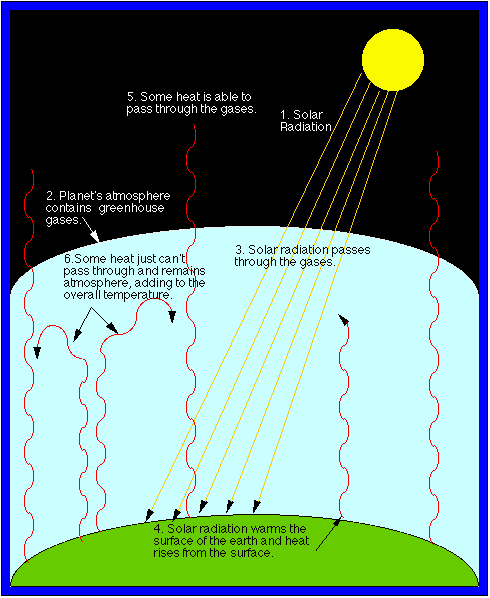 Diagram to help explain the process
of global warming and how greenhouse gases create the "greenhouse
effect"
www.eecs.umich.edu/mathscience/funexperiments/agesubject/lessons/images/diagrampage.html
Diagram to help explain the process
of global warming and how greenhouse gases create the "greenhouse
effect"
www.eecs.umich.edu/mathscience/funexperiments/agesubject/lessons/images/diagrampage.html
Greenhouse
Gases
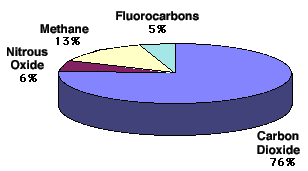 This graph shows the distribution
of GHG in Earth's atmosphere. Carbon Dioxide is clearly the
majority.
www.abcnews.com/sections/us/global106.html
Carbon
Dioxide
Carbon Dioxide (CO2) is a colorless, odorless non-flammable gas and is the most
prominent Greenhouse gas in Earth's atmosphere. It is recycled through the
atmosphere by the process photosynthesis, which makes human life possible.
Photosynthesis is the process of green plants and other organisms transforming
light energy into chemical energy. Light Energy is trapped and used to
convert carbon dioxide, water, and other minerals into oxygen and energy rich
organic compounds. (Encyclopaedia Britannica Volume 25)
Carbon Dioxide is emitted into the air as humans exhale, burn
fossil fuels for energy, and deforest the planet. Every year humans add
over 30 billion tons of carbon dioxide in the atmosphere by these processes, and
it is up thirty percent since 1750
(www.envirolink.org/orgs/edf/sitemap.html). An isolated test
at Mauna Loa in Hawaii revealed more than a 12% (316 ppm in 1959 to 360 ppm in
1996) increase in mean annual concentration of carbon dioxide. Mauna Loa,
located in Hawaii, is the worlds largest volcano at 40,000 cubic km and
4,170 meters above sea level. (Encyclopedia Britannica Volume 27)
. Ice core samples have also shown a dramatic increase in carbon dioxide
levels. Drilling deep into glaciers and polar ice caps and taking out
samples of ice, then melting the ice and capturing the gas has shown an increase
in carbon dioxide concentrations over the past 100 years. Ice core samples
are essentially "drilling through time", because the deeper the ice is, the
older the ice is.
This graph shows the distribution
of GHG in Earth's atmosphere. Carbon Dioxide is clearly the
majority.
www.abcnews.com/sections/us/global106.html
Carbon
Dioxide
Carbon Dioxide (CO2) is a colorless, odorless non-flammable gas and is the most
prominent Greenhouse gas in Earth's atmosphere. It is recycled through the
atmosphere by the process photosynthesis, which makes human life possible.
Photosynthesis is the process of green plants and other organisms transforming
light energy into chemical energy. Light Energy is trapped and used to
convert carbon dioxide, water, and other minerals into oxygen and energy rich
organic compounds. (Encyclopaedia Britannica Volume 25)
Carbon Dioxide is emitted into the air as humans exhale, burn
fossil fuels for energy, and deforest the planet. Every year humans add
over 30 billion tons of carbon dioxide in the atmosphere by these processes, and
it is up thirty percent since 1750
(www.envirolink.org/orgs/edf/sitemap.html). An isolated test
at Mauna Loa in Hawaii revealed more than a 12% (316 ppm in 1959 to 360 ppm in
1996) increase in mean annual concentration of carbon dioxide. Mauna Loa,
located in Hawaii, is the worlds largest volcano at 40,000 cubic km and
4,170 meters above sea level. (Encyclopedia Britannica Volume 27)
. Ice core samples have also shown a dramatic increase in carbon dioxide
levels. Drilling deep into glaciers and polar ice caps and taking out
samples of ice, then melting the ice and capturing the gas has shown an increase
in carbon dioxide concentrations over the past 100 years. Ice core samples
are essentially "drilling through time", because the deeper the ice is, the
older the ice is.
In 1996, carbon dioxide world
emissions increased by 2.8%. The U.S. reported a 3.3% increase in CO2
concentrations. The U.S. continues to emit more than any other country
in the world, accounting for 25% of all emissions. The European Union had an
increase of 2.2%, much larger than a small increase of 1.1% in 1995.
Eastern Europe had a decreasing rate of -2.4%. China's increase in 1996
was 4.7%.(http://infoweb.magi.com/~dwalsh/wfsesr.html)
Fossil Fuels were created chiefly by the decay of
plants from millions of years ago. We use coal, oil and natural gas to generate
electricity, heat our homes, power our factories and run our cars. These
fossil fuels contain carbon, and when they are burned, they combine with oxygen,
forming carbon dioxide. The two atoms of oxygen add to the total
weight. The World Energy Council reported that global carbon dioxide
emissions from buring fossil fuels rose 12% between 1990 and 1995.
(www.eb.com:180) The increase from developing countries was three times
that from developed countries. Middle East carbon dioxide emissions from burning
of fossil fuels increased 35%, Africa increased 12%, and Eastern Europe
increased rates by 75% from 1990-1995.
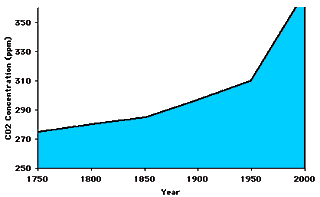 This graph shows the increase
of carbon dioxide in the air over the past few
centuries
This graph shows the increase
of carbon dioxide in the air over the past few
centuries
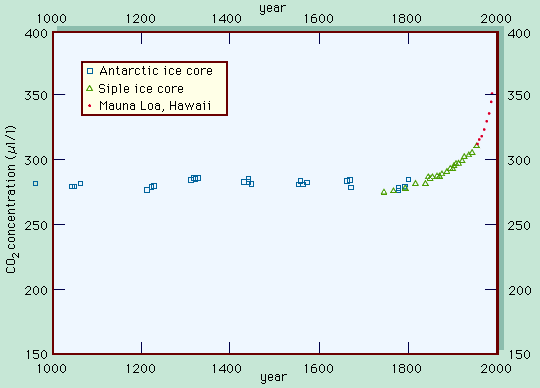 Ice Core samples and samples at
Mauna Loa, Hawaii, reveal an increase CO2
concentrations
Ice Core samples and samples at
Mauna Loa, Hawaii, reveal an increase CO2
concentrations
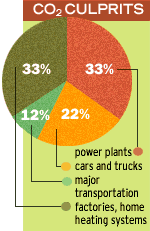 Pie chart shows how CO2 is
produced
www.envirolink.org/orgs/edf/sitemap.html
Pie chart shows how CO2 is
produced
www.envirolink.org/orgs/edf/sitemap.html
 Cars also contribute to CO2 in the
atmosphere.
www.abcnews.com/sections/us/global106/index.html
Cars also contribute to CO2 in the
atmosphere.
www.abcnews.com/sections/us/global106/index.html
Deforestation is another main producer of
carbon dioxide. The causes of deforestation are logging for lumber,
pulpwood, and fuel wood. Also contributing to deforestation are clearing
new land for farming and pastures used for animals such as cows. Forests
and wooded areas are natural carbon sinks. This means that as trees absorb
carbon dioxide, and release oxygen, carbon is being put into trees. This
process occurs naturally by photosynthesis, which occurs less and less as we cut
and burn down trees. As the abundance of trees declines, less carbon
dioxide can be recycled. As we burn them down, carbon is released into the
air and the carbon bonds with oxygen to form carbon dioxide, adding to the
greenhouse effect. About 860 acres, the size of Central Park in New York,
is destroyed every 15 minutes in the tropics.
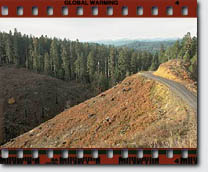
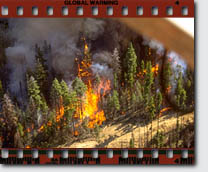 Deforestation and Forest Fires
contribute to an increase in CO2 levels
www.envirolink.org/orgs/edf/sitemap.html
Deforestation and Forest Fires
contribute to an increase in CO2 levels
www.envirolink.org/orgs/edf/sitemap.html
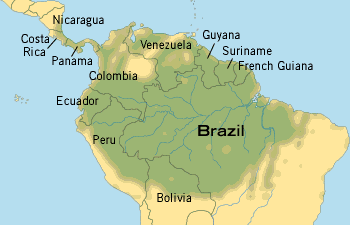 The Amazon Rain Forest, which
is in parts of Brazil, French Guiana, Suriname, Guyana, Venezuela, Nicaragua,
Costa Rica, Panama, Columbia, Ecuador, Peru, and Bolivia, is subjected to a
great deal of deforestation
www.abcnews.com/sections/us/global106.html
The Amazon Rain Forest, which
is in parts of Brazil, French Guiana, Suriname, Guyana, Venezuela, Nicaragua,
Costa Rica, Panama, Columbia, Ecuador, Peru, and Bolivia, is subjected to a
great deal of deforestation
www.abcnews.com/sections/us/global106.html
Methane
Methane is a colorless, odorless, flammable gas. It is formed when
plants decay and where there is very little air. It is often called
swamp gas because it is abundant around water and swamps. Bacteria
that breakdown organic matter in wetlands and bacteria that are found in cows,
sheep, goats, buffalo, termites, and camels produce methane naturally.
Since 1750, methane has doubled, and could double again by 2050. Each year
we add 350-500 million tons of methane to the air by raising livestock, coal
mining, drilling for oil and natural gas, rice cultivation, and garbage sitting
in landfills.(www.envirolink.org/orgs/edf/sitemap.html) It stays in the
atmosphere for only 10 years, but traps 20 times more heat than carbon dioxide.
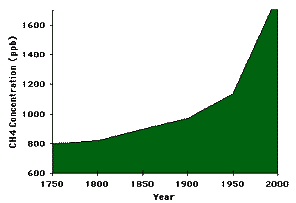 Methane is on the rise since
1750
www.envirolink.org/orgs/edf/sitemap.html
Methane is on the rise since
1750
www.envirolink.org/orgs/edf/sitemap.html
Rice cultivation has developed into a large
business; farmland has doubled in the past 45
years.(www.envirolink.org/orgs/edf/sitemap.html) It feeds 1/3 of the
World's population. It grows mostly in flooded fields, where bacteria in
waterlogged soil releases methane.
Livestock such as cows, sheep, goats, camels,
buffaloes, and termites release methane as well. Bacteria in the gut of
the animal break down food and convert some of it to methane. When these animals
belch, methane is released. In one day, a cow can emit ½ pound of methane
into the air. Imagine 1.3 billion cattle each burping methane several
times per minute!
 Cows such as these contribute a
large amount of methane to the air.
www.envirolink.org/orgs/edf/sitemap.html
Cows such as these contribute a
large amount of methane to the air.
www.envirolink.org/orgs/edf/sitemap.html
Nitrous Oxide Nitrous
oxide is another colorless greenhouse gas, however, it has a sweet odor .
It is primarily used as an anesthetic because it deadens pain and for this
characteristic is called laughing gas. This gas is released naturally
from oceans and by bacteria in soils. Nitrous oxide gas risen by more than
15% since 1750. Each year we add 7-13 million tons into the
atmosphere by using nitrogen based fertilizers, disposing of human and animal
waste in sewage treatment plants, automobile exhaust, and other sources not yet
identified. It is important to reduce emissions because the nitrous oxide
we release today will still be trapped in the atmosphere 100 years from now.
(World Book Volume 13)
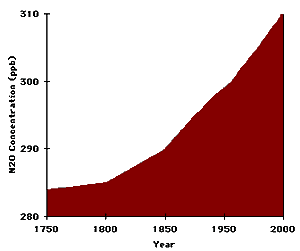 Nitrous Oxide has been on the rise
since 1750
www.envirolink.org/orgs/edf/sitmap.html
Nitrous Oxide has been on the rise
since 1750
www.envirolink.org/orgs/edf/sitmap.html
Nitrogen based fertilizer use has doubled in the
past 15 years. These fertilizers provide nutrients for crops; however,
when they breakdown in the soil, nitrous oxide is released into the
atmosphere. In automobiles, nitrous oxide is released at a much lower rate
than carbon dioxide, because there is more carbon in gasoline than nitrogen.
Fluorocarbons
Fluorocarbons is a general term for any group of synthetic organic compounds
that contain fluorine and carbon. Many of these compounds, such as
chlorofluorocarbons(CFCs), can be easily converted from gas to liquid or liquid
to gas. Because of these properties, CFCs can be used in aerosol cans,
refrigerators, and air conditioners. Studies in the 1970s showed that
when CFCs are emitted into the atmosphere, they break down molecules in the
Earth's ozone layer (World Book). Since then, the use of CFCs has
significantly decreased and they are banned from production in the United
States.
The substitute for CFCs are hydrofluorocarbons (HFC's). HFCs
do not harm or breakdown the ozone molecule, but they do trap heat in the
atmosphere, making it a greenhouse gas, aiding in global warming. HFCs
are used in air conditioners and refrigerators. The way to reduce
emissions of this gas is to be sure that in both devices the coolant is recycled
and all leaks are properly fixed . Also, before throwing the appliances
away, be sure to recover the coolant in each.

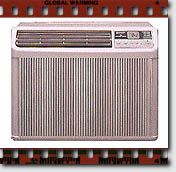 Refrigerators and Air
Conditioners using CFC's were a huge problem for the ozone layer, but now HFC's
are a problem for the climate.
www.envirolink.org/orgs/edf/sitemap.html
Refrigerators and Air
Conditioners using CFC's were a huge problem for the ozone layer, but now HFC's
are a problem for the climate.
www.envirolink.org/orgs/edf/sitemap.html
Global Warming is
Here Naturally, if there are
more greenhouse gases in the atmosphere, this greenhouse effect will be more
significant and raise the temperature of Earth more than if humans didn't emit
as much greenhouse gases. Peter Tans, a physicist with National Oceanic
and Atmospheric Administrations (NOAA) Climate Monitoring and Diagnostics Lab
says, There is no doubt that both land and ocean surface temperatures have gone
up significantly in the last 100 years or so.
(www.abcnew.com/sections/us/global106.html) This statement supports the
trend of global warming, but does not acknowledge the source. The director
of NOAAs Geophysical Fluid Dynamics Lab at Princeton, Jerry Malhan, says, The
Earths surface temperature has warmed about one degree Fahrenheit in the last
100 years, and there is no credible hypothesis for this, other than the net
effect of greenhouse gases."
(www.abcnews.com/sections/us/global106.index.html) Jerry Malhan offers a
quote supporting the theory of global warming and also states that it is
directly related to the increase of greenhouse gases. The planet is
heating up and the evidence suggests that human activities are having a
significant impact, Jane Lubchenco said.
(www.abcnews.com/sections/us/global106/index.html) Jane was the past
President of the American Association for the Advancement of Science, who
briefed President Clinton on global warming in July, 1997. The world's
leading authority on global warming, the Intergovernmental Panel on Climate
Change (IPCC), is a United Nations sponsored organization made up of 2500
scientists from around the world. They have concluded by consensus that "The
balance of evidence suggests a discernible human influence on global climate."
They project that global warming will have severe impacts on human health,
natural ecosystems, agriculture, and coastal communities.
(www.toowarm.org./factsheets/basfact.html)
This evidence supports the
common belief that Global Warming is occurring due to the increased
concentration of greenhouse gases in the atmosphere, carbon dioxide, nitrous
oxide, methane, and HFCs.
 Average yearly temperature rise:
1860-1998
www.evirolink.org/orgs/edf/sitemap.html
Average yearly temperature rise:
1860-1998
www.evirolink.org/orgs/edf/sitemap.html
Effects of Global Warming on
Environment There are
many environmental problems coming from the increase concentration of
greenhouse gases in Earth's atmosphere. As Jeff Rubin of ABC NEWS
reported, Several signs indicate that we've begun changing Earth's
climate: increased water vapor in the atmosphere, glaciers and polar ice
caps appear to be melting, floods and droughts are becoming more severe, and sea
levels have risen, on average, between 4 and 10 inches since 1990.
(www.abc.com/sections/us/global106.html) Experts concur, We are already
beginning to see this (global warming) taking place - a lot more flooding, a lot
more droughts, Jane Lubchenco said. Jerry Malham added, By 2100, we might get
a 2 foot sea level rise, but the catch is, levels might continue to rise 2 or 3
feet per century, for 1000
years.(www.abcnews.com/sections/us/global106.html) These rises in sea
level can increase the salinity of freshwater throughout the world, and cause
coastal lands to be washed under the ocean. Warmer water and increased
humidity may encourage tropical cyclones, and changing wave patterns could
produce more tidal waves and strong beach erosion on the coasts.
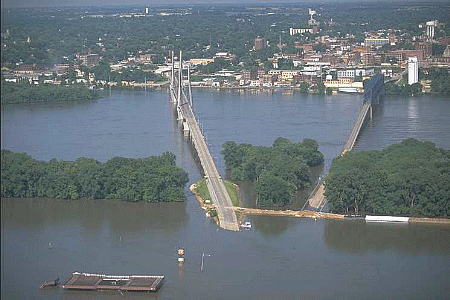 Flooding form global warming may be
already happening.
www.abcnews.com/sections/us/global106.html
Flooding form global warming may be
already happening.
www.abcnews.com/sections/us/global106.html
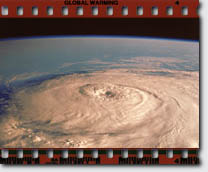 Picture of a typhoon from
space
www.envirolink.org/orgs/edf/sitemap.html
Picture of a typhoon from
space
www.envirolink.org/orgs/edf/sitemap.html
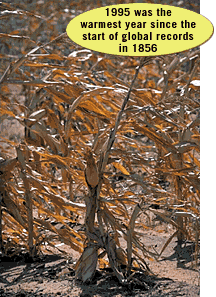 The effects of droughts on
crops
www.abcnews.com/sections/us/global106.html
The effects of droughts on
crops
www.abcnews.com/sections/us/global106.html
Effects of Global Warming on
Society Agriculturally, Dr.
Sylvan H. Wittwer believes that global warming is good for the human race,
because it helps increase food production. "The most determinant factor in
agriculture production is climate. History reveals that for food
production, warming is better than cooling." Dr. Wittwer says that carbon
dioxide is an essential nutrient for the production of food, and food is one of
the most important things in our lives. As the temperature rises, more farmland
will be open towards the poles and the length of the growing season will also
lengthen. With all the people who go hungry each day, Dr. Wittwer believes
food production should be one of our main concerns. Dr. Wittwer is the
scientific pioneer who conducted the original studies on atmospheric CO2
enhancement of the production of food crops.(www.comnett.net/~wit/food.html)
Increasing amounts of greenhouse gases in the atmosphere
and global warming could also lead to more health concerns. A statement
released from the Intergovernmental Panel on Climate Change (IPCC) said,
"Climate change is likely to have wide-ranging and mostly adverse impacts on
human health, with significant loss of life." As temperatures increase
towards the poles, similar to farmland, insects and other pests migrate towards
Earth's poles. These insects and pests could be allowed to migrate up to 550 Km
or 550 miles. Some insects carry diseases such as malaria and dengue
fever. Thus, an increase in these particular insects and pests closer to
the poles results in an increase in these diseases. This could lead to 50
to 80 million additional cases of Malaria annually, a 10-15% increase.
"Malaria and dengue fever are already beginning to spread pole wards", said Jane
Lubchenco, past president of American Association for the advancement of
science. (www.epa.gov/oppeoeel/globalwarming/impacts/health/index.html)
Physician Paul Epstein, of Harvard's School of Public Health, says "Climate
change is already a factor in terms of the distributions of malaria, dengue
fever, and cholera." (www.aloha.net~jhanson/page70.htm)
The most obvious health effect is directly from the heat
itself. With an increase in heat waves, there will be more people who will
suffer from heatstroke, heart attacks and other ailments aggravated by the
heat. According to the EPA, "In July 1995, a heat wave killed more than
700 people in the Chicago area alone."
(www.epa.gov/oppeoeel/globalwarming/impacts/health/index.html) If
this is happening already from heat, imagine what would occur in the future with
global warming. Hot conditions could also cause smoke particles and
noxious gases to linger in the air and accelerate chemical reactions that
generate other pollutants. (www.envirolink.org/orgs/edf/sitemap.html) This leads
to an increase in risk of respiratory diseases like bronchitis and asthma.
Global warming causes the oceans to warm and expand,
inducing a rise in sea level. Eventually, the rising waters could take away land
inhabited by people, forcing them to move. Dr. Robert Buddemieir, of the
Kansas Geological Survey said, "Bangledesh is massively populated, achingly
poor, and something like a sixth of the country is going to go away"
(www.envirolink.org/orgs/edf/sitemap.html) Bangladesh cannot afford to
build barriers to hold back the sea, so people would have to move inland,
increasing the populations density and leading to an increase in hunger and
disease. (www.envirolink.org/orgs/edf/sitemap.html) The Maldive Islands in
the Indian Ocean have the same problem They are a nation of 1190 islands
with an average height of about 1.5 meters above sea level. If the sea
level rises, more than 200,000 people will have to abandon their homes.
(www.envirolink.org/orgs/edf/sitmap.html) Warming of the oceans
could also promote toxic algae which can lead to cholera.
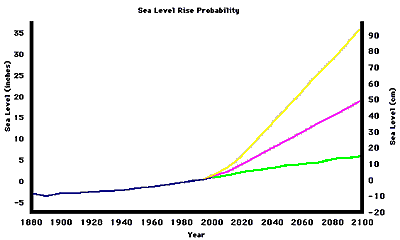 Graph showing history of sea level
and extrapolating possible increases in sea level over the next
century
The blue line represents the
history of sea level. The yellow line is a high estimate of sea level
extrapolated. The red line a central estimate, and the green line is a low
projection.
www.envirolink.org/orgs/edf/sitemap.html
Graph showing history of sea level
and extrapolating possible increases in sea level over the next
century
The blue line represents the
history of sea level. The yellow line is a high estimate of sea level
extrapolated. The red line a central estimate, and the green line is a low
projection.
www.envirolink.org/orgs/edf/sitemap.html
The Present ways of Producing
Energy
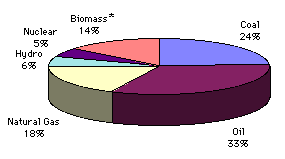 This pie graph shows the breakdown
of how the world produces its energy
www.envirolink.org/orgs/edf/sitemap.html
Fossil fuels, chiefly coal, oil and natural gas, now supply most of the world's
energy. Only a small amount comes from renewable sources , which do not release
gases that trap heat in the atmosphere. If we could get more of our energy from
renewable sources, we could reduce the amount of fossil fuels we burn. By
the year 2050, renewable sources could provide forty percent of the energy
needed in the world. Use of renewable energy can help both to slow global
warming and to reduce air pollution. (www.doc.mmu.ac.uk/aric/gcc/cell.html#pos6)
This pie graph shows the breakdown
of how the world produces its energy
www.envirolink.org/orgs/edf/sitemap.html
Fossil fuels, chiefly coal, oil and natural gas, now supply most of the world's
energy. Only a small amount comes from renewable sources , which do not release
gases that trap heat in the atmosphere. If we could get more of our energy from
renewable sources, we could reduce the amount of fossil fuels we burn. By
the year 2050, renewable sources could provide forty percent of the energy
needed in the world. Use of renewable energy can help both to slow global
warming and to reduce air pollution. (www.doc.mmu.ac.uk/aric/gcc/cell.html#pos6)
These fossil fuels, coal, oil, and natural gas also emit
greenhouse gases when burned. Coal emits high amounts of greenhouse gases,
and the world may be supplied with enough of it to last over 100 years.
Oil emits high amounts of greenhouse gases and also other types of air
pollution harmful to the environment. The world's oil supply is also estimated
to last over 100 years. Natural Gas is the lowest of all fossil fuels in
greenhouse gas emissions; supplies are projected to last over 100 years.
(www.doc.mmu.ac.uk/aric/gcc/cell.html#pos6)
1996 Processes Carbon Dioxide was Produced
|
Country (region) |
OIL |
Natural Gas |
Coal |
| World |
44.7% |
18.4% |
36.9% |
| Canada |
51.8% |
30% |
18.2% |
| United States |
45% |
21.3% |
33.7% |
| European Union |
56.2% |
19% |
24.8% |
| China |
17.4% |
1.1% |
81.5% |
| Japan |
64.6% |
9.9% |
25.5% |
This chart shows what
percentage of CO2 comes from Oil, Natural Gas, and Coal. For example, in 1996,
44.7% of the world's CO2 emissions came from the combustion of
oil.
http://infoweb.magi.com/~dwalsh/wfsesr.html

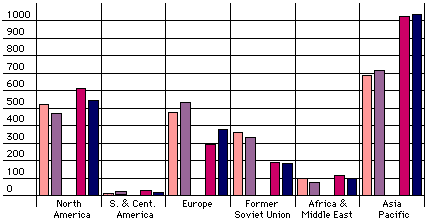



 This chart shows how much coal
different areas of the world have produced and consumed over
time
This chart shows how much coal
different areas of the world have produced and consumed over
time
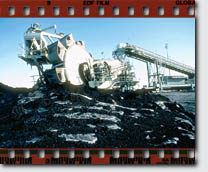
 Coal accounts for 24% of the
worlds energy; Natural gas 18%
www.envirolink.org/orgs/edf/sitemap.html
Coal accounts for 24% of the
worlds energy; Natural gas 18%
www.envirolink.org/orgs/edf/sitemap.html
Solutions for Producing
"Cleaner"Energy
Hydro
power, currently supplying only six percent of the world's energy, is a
renewable energy source. Energy is produced by hydraulic turbines that rotate
with the force of rushing water (higher to lower elevation). It is one of
the most clean and cheapest way of producing energy, but it can also change the
flow of rivers and increase sediment which kills fish. It is a large
investment for developing countries. (www.abcnews.com/sections/us/global106)
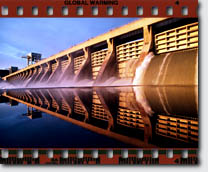 ]
Hydro Power plant on a
river
www.envirolink.org/orgs/edf/sitemap.html
]
Hydro Power plant on a
river
www.envirolink.org/orgs/edf/sitemap.html
Denmark is currently the world leader in wind power.
By 2030, fifty percent of Denmark's energy could be produced by wind
power. Randall Swisher, executive director of the American WInd Energy
Association says, "If this country made an aggressive development push, by 2020
eighteen percent of the country's energy could be supplied by wind power."
(www.abc.com/sections/us/global106.html) Wind power emits no
greenhouse gases, but it takes up large amounts of land. In order for it
to be a reliable source, scientists must develop better power storage
techniques. Another concern of people is noise pollution that the large
windmills produce along with the reliability of wind.
 A field of wind
mills
www.envirolink.org/orgs/edf/sitemap.html
A field of wind
mills
www.envirolink.org/orgs/edf/sitemap.html
Solar power uses photovoltaic cells (PV's) to
gather thermal energy directly from the sun and use it to produce
electricity. One community could be supplied by one field of PV's .
Passive solar cells could also be used to heat water, replacing the need for
today's hot water heaters. PV's do not emit any greenhouse gases, but they
are very expensive and more development is needed in order for this to be
realistic energy source for the future.
(www.abcnews.com/sections/us/global106.html)
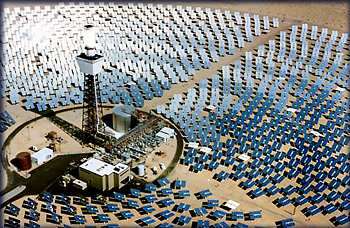 A field of PV's gathering sunlight
to produce power
www.abcnews.com/sections/us/global106.html
A field of PV's gathering sunlight
to produce power
www.abcnews.com/sections/us/global106.html
Nuclear power is strong is Europe with about
forty-two percent of their energy produced by fission. Nuclear generation
provides about 17% of world electricity, avoiding the emission of up to 2.3
billion tonnes of carbon dioxide annually. France produces 76% and Lithuania
produces 85.6% of its energy by nuclear
fission.(http://infoweb.magi.com/~dwalsh/wfsesr.html) In the United
States, people are antinuclear because of 3 Mile Island in 1979 and Chernobyl in
1986. However, many experts say that it is a safe, clean, and reliable
source of energy. Nuclear Fission produces no greenhouse gases, but does
produce highly toxic radioactive wastes.
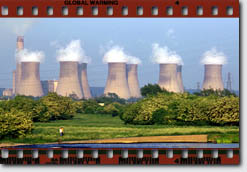 Nuclear power plants have had
success in Europe, but not in the United States
www.envirolink.org/orgs/edf/sitemap.html
Nuclear power plants have had
success in Europe, but not in the United States
www.envirolink.org/orgs/edf/sitemap.html
Kyoto
Protocol One of the major
conventions concerning global warming resulted in the Kyoto Protocol, held in
Kyoto, Japan, between December 1-11, 1997. Delegates from all over the world
were present in order to find a universal agreement to reduce greenhouse gas
emissions. The results had most developed nations doing most of the
reducing; the United States must cut emissions 7%, Japan 6%, and the European
Union 8% below 1990 levels.
(www.state.gov/global/oes/fs_kyoto_climate_980115.html)
The United States proposed a plan to have these levels cut
over a five year period between 2008-2013. The United States also
said it will not sign the protocol if other developing/undeveloped countries do
not sign it as well, fearing the economy will falter. The U.S. was
successful in emissions trading with other countries who have less emissions.
This means that the U.S. or other developed countries can purchase emission
permits from other countries who have extra permits. This stresses the
importance of flexibility the U.S. was looking for when it said it cannot lower
the emission levels until at least 2008. Again, the U.S. is trying to look
out for it's own economy first. If a country shall fail in completing its
goal, the country will then not be able to receive joint implementation
projects. However, this Protocol is not yet law; it must be ratified by at
least 55 countries, accounting for 55% of the world's total greenhouse gas
emissions.. It can be signed by countries starting in March of 1998.
The next convention is in November 1998, in Buenos Aires.
(www.state.gov/global/oes/fs_kyoto_climate_980115.html)
If the Kyoto Protocol becomes the law of the land, there
are potential economic problems that may lead to a change in quality of
life for many Americans. By reducing greenhouse gas emissions, people will
be more healthy due to better air quality and water quality. However,
there may be a reduction in the rate of economic development because industries
will have to adapt and find different ways of producing goods. People will
have to drive smaller, lighter cars, ride bicycles more often, and increase
efficiency in many ways.
Opinion The
world's leading scientists project that during our children's lifetimes global
warming will raise the average temperature of the planet by 2 to 6 degrees
Fahrenheit, or 1-3.5 degree Celsius. In contrast the Earth is only 5 to 9
degrees Fahrenheit or about 3-6 degrees Celsius warmer today than it was 10,000
years ago during the last ice age. Man-made global warming is occurring much
faster than at any other time in at least the last 10,000 years.
(www.toowarm.org/factsheets/basfact.html#How) This information would
suggest that the warming Earth is experiencing now is not a natural phenomenon,
but caused by the increased concentration of greenhouse gases.
While evidence is strong to support the notion of
human contribution to the global warming problem, an alternative view is that
recent global warming is a natural occurrence. Some theorists believe that
the Earth's climate works in a cycle, cooling, and then warming itself.
Scientists point out the fact that 75 million years ago, the Earth's average
temperature was ten degrees higher than it is today. Conditions were
warmer and more humid, but life sustained.
(www.enviolink.org/orgs/edf/sitemap.html)
Another
phenomenon to take into account is the "little ice age", which occurred from
1550-1850 A.D. Conditions around the world were cooler than usual; many
bodies of water froze over. The average global temperature since the
little ice age has risen by one degree Fahrenheit! Shouldn't it be
expected that after that ice age was over that the temperature on Earth would
rise at least one degree?
The bottom line is that it may
seem that only human actions are causing global warming, but it is very possible
that global warming is nothing to worry about and is just part of the global
temperature cycle. Both theories are credible, but neither has yet been
proven.
Terms1. Carbon Dioxide - a
heavy colorless gas that does not support combustion, dissolves in water to form
carbonic acid, is formed especialy in animal repiration and in the decay or
combustion of animal and vegetable matter, is absorbed from the air by plants in
photosynthesis, and is used in the carbonation of beverages.
2. Methane- a colorless odorless flammable gaseous hydrocarbon
that is a product of decompositions of organic matter and of the carbonization
of coal, is used as a fuel and as a starting material in chemical synthesis, and
is the simplest of the alkanes.
3. Photosynthesis- synthesis of chemical compounds with the aid of
radiant energy and especially light; especially formation of carbohydrates from
carbon dioxide and a source of hydrogen in the chlorophyll-containing tissues of
plants exposed to light
4. Greenhouse Effect- warming of the surface and lower atmosphere of a
planet that is caused by conversion of solar radiation into heat in a process
involving selective transmission of short wave solar radiation by the atosphere,
its absorption by the planet's surface, and reradiation as infared which is
absorbed and partly reradiated back to the surface by atmospheric gases.
5. Nitrous oxide - a colorless gas that when inhaled produces loss of
sensibility to pain preceded by exhilaration and sometimes laughter and is used
as an anesthetic in dentistry and that is an atmospheric pollutant produced by
combustion and a suspected contributor to greenhouse warming -- also
called laughing gas.
6. Malaria - a human disease that is caused by sporazoan
parasites in the red blood cells, is transmitted by the bite of anopheline
mosquitoes, and is characterized by peo\riodic attacks of chills and fever
7. Dengue - an acute infectious disease caused by an arbovirus,
transmitted by aedes mosquitoes, and characterized by headache, severe joint
pain, and a rash--called also dengue fever.
References
1. "Estimation of Emissions of Carbon Dioxide at the local level: A Low
cost approach for local authorities." Atmospheric Research and
Information Center. http://doc.mmu.ac.uk/aric/gcc/cell.html#pos6
(March 8, 1998)
2. "Global Warming is Happening." Envirolink.
http://www.envirolink.org/prgs/edf/sitemap.html (March 8, 1998)
3. "Global Warming Campaign." Sierra Club.
http://www.toowarm.org/factsheets/basfact.html (March 12, 1998)
4. "Methane" World Book Encyclopaedia. Volume 7. Friend,
1982, p. 270
5. "Fluorocarbons" World Book Encyclopedia. Volume
13. Hatch, 1982, p. 358
6. "Clinton: We're Energy Hogs." ABC News.
http://www.abcnews.com/sections/us/global106.html (March 8, 1998)
7. "Global Warming." United States Environmental Protection
Agency. http://www.epa.gov/globalwarming/ (March 8, 1998)
8. "The Kyoto Protocol on Climate Change." U.S.
Department of State
http://www.state.gov/www/global/oes/fs_kyoto_climate_980115.html (March 9, 1998)
9. Sylvan H. Wittwer. "It's Good for Food Production" The
Global Environment. http://www.comnett.net/~wit/food.html
(March 8, 1998)
10. "Greenhouse Effect" Encyclopaedia Britannica. Volume
5. 1988, p. 470
11. "Photosynthesis" Encyclopaedia Britannica.
Volume 25. 1988, pp.808-816
http://infoweb.magi.com/~dwalsh/wfsesr.html)

 Deforestation and Forest Fires
contribute to an increase in CO2 levels
www.envirolink.org/orgs/edf/sitemap.html
Deforestation and Forest Fires
contribute to an increase in CO2 levels
www.envirolink.org/orgs/edf/sitemap.html
 The Amazon Rain Forest, which
is in parts of Brazil, French Guiana, Suriname, Guyana, Venezuela, Nicaragua,
Costa Rica, Panama, Columbia, Ecuador, Peru, and Bolivia, is subjected to a
great deal of deforestation
www.abcnews.com/sections/us/global106.html
The Amazon Rain Forest, which
is in parts of Brazil, French Guiana, Suriname, Guyana, Venezuela, Nicaragua,
Costa Rica, Panama, Columbia, Ecuador, Peru, and Bolivia, is subjected to a
great deal of deforestation
www.abcnews.com/sections/us/global106.html
 Diagram to help explain the process
of global warming and how greenhouse gases create the "greenhouse
effect"
www.eecs.umich.edu/mathscience/funexperiments/agesubject/lessons/images/diagrampage.html
Diagram to help explain the process
of global warming and how greenhouse gases create the "greenhouse
effect"
www.eecs.umich.edu/mathscience/funexperiments/agesubject/lessons/images/diagrampage.html
 This graph shows the distribution
of GHG in Earth's atmosphere. Carbon Dioxide is clearly the
majority.
www.abcnews.com/sections/us/global106.html
Carbon
Dioxide
Carbon Dioxide (CO2) is a colorless, odorless non-flammable gas and is the most
prominent Greenhouse gas in Earth's atmosphere. It is recycled through the
atmosphere by the process photosynthesis, which makes human life possible.
Photosynthesis is the process of green plants and other organisms transforming
light energy into chemical energy. Light Energy is trapped and used to
convert carbon dioxide, water, and other minerals into oxygen and energy rich
organic compounds. (Encyclopaedia Britannica Volume 25)
Carbon Dioxide is emitted into the air as humans exhale, burn
fossil fuels for energy, and deforest the planet. Every year humans add
over 30 billion tons of carbon dioxide in the atmosphere by these processes, and
it is up thirty percent since 1750
(www.envirolink.org/orgs/edf/sitemap.html). An isolated test
at Mauna Loa in Hawaii revealed more than a 12% (316 ppm in 1959 to 360 ppm in
1996) increase in mean annual concentration of carbon dioxide. Mauna Loa,
located in Hawaii, is the worlds largest volcano at 40,000 cubic km and
4,170 meters above sea level. (Encyclopedia Britannica Volume 27)
. Ice core samples have also shown a dramatic increase in carbon dioxide
levels. Drilling deep into glaciers and polar ice caps and taking out
samples of ice, then melting the ice and capturing the gas has shown an increase
in carbon dioxide concentrations over the past 100 years. Ice core samples
are essentially "drilling through time", because the deeper the ice is, the
older the ice is.
This graph shows the distribution
of GHG in Earth's atmosphere. Carbon Dioxide is clearly the
majority.
www.abcnews.com/sections/us/global106.html
Carbon
Dioxide
Carbon Dioxide (CO2) is a colorless, odorless non-flammable gas and is the most
prominent Greenhouse gas in Earth's atmosphere. It is recycled through the
atmosphere by the process photosynthesis, which makes human life possible.
Photosynthesis is the process of green plants and other organisms transforming
light energy into chemical energy. Light Energy is trapped and used to
convert carbon dioxide, water, and other minerals into oxygen and energy rich
organic compounds. (Encyclopaedia Britannica Volume 25)
Carbon Dioxide is emitted into the air as humans exhale, burn
fossil fuels for energy, and deforest the planet. Every year humans add
over 30 billion tons of carbon dioxide in the atmosphere by these processes, and
it is up thirty percent since 1750
(www.envirolink.org/orgs/edf/sitemap.html). An isolated test
at Mauna Loa in Hawaii revealed more than a 12% (316 ppm in 1959 to 360 ppm in
1996) increase in mean annual concentration of carbon dioxide. Mauna Loa,
located in Hawaii, is the worlds largest volcano at 40,000 cubic km and
4,170 meters above sea level. (Encyclopedia Britannica Volume 27)
. Ice core samples have also shown a dramatic increase in carbon dioxide
levels. Drilling deep into glaciers and polar ice caps and taking out
samples of ice, then melting the ice and capturing the gas has shown an increase
in carbon dioxide concentrations over the past 100 years. Ice core samples
are essentially "drilling through time", because the deeper the ice is, the
older the ice is.  This graph shows the increase
of carbon dioxide in the air over the past few
centuries
This graph shows the increase
of carbon dioxide in the air over the past few
centuries
 Ice Core samples and samples at
Mauna Loa, Hawaii, reveal an increase CO2
concentrations
Ice Core samples and samples at
Mauna Loa, Hawaii, reveal an increase CO2
concentrations
 Pie chart shows how CO2 is
produced
www.envirolink.org/orgs/edf/sitemap.html
Pie chart shows how CO2 is
produced
www.envirolink.org/orgs/edf/sitemap.html
 Cars also contribute to CO2 in the
atmosphere.
www.abcnews.com/sections/us/global106/index.html
Cars also contribute to CO2 in the
atmosphere.
www.abcnews.com/sections/us/global106/index.html
 Methane is on the rise since
1750
www.envirolink.org/orgs/edf/sitemap.html
Methane is on the rise since
1750
www.envirolink.org/orgs/edf/sitemap.html
 Cows such as these contribute a
large amount of methane to the air.
www.envirolink.org/orgs/edf/sitemap.html
Cows such as these contribute a
large amount of methane to the air.
www.envirolink.org/orgs/edf/sitemap.html
 Nitrous Oxide has been on the rise
since 1750
www.envirolink.org/orgs/edf/sitmap.html
Nitrous Oxide has been on the rise
since 1750
www.envirolink.org/orgs/edf/sitmap.html

 Refrigerators and Air
Conditioners using CFC's were a huge problem for the ozone layer, but now HFC's
are a problem for the climate.
www.envirolink.org/orgs/edf/sitemap.html
Refrigerators and Air
Conditioners using CFC's were a huge problem for the ozone layer, but now HFC's
are a problem for the climate.
www.envirolink.org/orgs/edf/sitemap.html
 Average yearly temperature rise:
1860-1998
www.evirolink.org/orgs/edf/sitemap.html
Average yearly temperature rise:
1860-1998
www.evirolink.org/orgs/edf/sitemap.html
 Flooding form global warming may be
already happening.
www.abcnews.com/sections/us/global106.html
Flooding form global warming may be
already happening.
www.abcnews.com/sections/us/global106.html
 Picture of a typhoon from
space
www.envirolink.org/orgs/edf/sitemap.html
Picture of a typhoon from
space
www.envirolink.org/orgs/edf/sitemap.html
 The effects of droughts on
crops
www.abcnews.com/sections/us/global106.html
The effects of droughts on
crops
www.abcnews.com/sections/us/global106.html
 Graph showing history of sea level
and extrapolating possible increases in sea level over the next
century
The blue line represents the
history of sea level. The yellow line is a high estimate of sea level
extrapolated. The red line a central estimate, and the green line is a low
projection.
www.envirolink.org/orgs/edf/sitemap.html
Graph showing history of sea level
and extrapolating possible increases in sea level over the next
century
The blue line represents the
history of sea level. The yellow line is a high estimate of sea level
extrapolated. The red line a central estimate, and the green line is a low
projection.
www.envirolink.org/orgs/edf/sitemap.html
 This pie graph shows the breakdown
of how the world produces its energy
www.envirolink.org/orgs/edf/sitemap.html
Fossil fuels, chiefly coal, oil and natural gas, now supply most of the world's
energy. Only a small amount comes from renewable sources , which do not release
gases that trap heat in the atmosphere. If we could get more of our energy from
renewable sources, we could reduce the amount of fossil fuels we burn. By
the year 2050, renewable sources could provide forty percent of the energy
needed in the world. Use of renewable energy can help both to slow global
warming and to reduce air pollution. (www.doc.mmu.ac.uk/aric/gcc/cell.html#pos6)
This pie graph shows the breakdown
of how the world produces its energy
www.envirolink.org/orgs/edf/sitemap.html
Fossil fuels, chiefly coal, oil and natural gas, now supply most of the world's
energy. Only a small amount comes from renewable sources , which do not release
gases that trap heat in the atmosphere. If we could get more of our energy from
renewable sources, we could reduce the amount of fossil fuels we burn. By
the year 2050, renewable sources could provide forty percent of the energy
needed in the world. Use of renewable energy can help both to slow global
warming and to reduce air pollution. (www.doc.mmu.ac.uk/aric/gcc/cell.html#pos6)


 Coal accounts for 24% of the
worlds energy; Natural gas 18%
www.envirolink.org/orgs/edf/sitemap.html
Coal accounts for 24% of the
worlds energy; Natural gas 18%
www.envirolink.org/orgs/edf/sitemap.html
 ]
Hydro Power plant on a
river
www.envirolink.org/orgs/edf/sitemap.html
]
Hydro Power plant on a
river
www.envirolink.org/orgs/edf/sitemap.html
 A field of wind
mills
www.envirolink.org/orgs/edf/sitemap.html
A field of wind
mills
www.envirolink.org/orgs/edf/sitemap.html
 A field of PV's gathering sunlight
to produce power
www.abcnews.com/sections/us/global106.html
A field of PV's gathering sunlight
to produce power
www.abcnews.com/sections/us/global106.html
 Nuclear power plants have had
success in Europe, but not in the United States
www.envirolink.org/orgs/edf/sitemap.html
Nuclear power plants have had
success in Europe, but not in the United States
www.envirolink.org/orgs/edf/sitemap.html